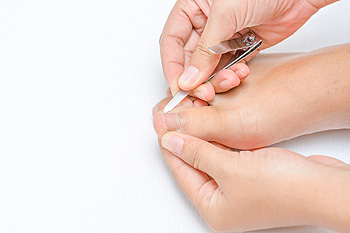What to Do About an Ingrown Toenail?

An ingrown toenail, also known as onychocryptosis, is when part of the toenail grows into the surrounding skin. If not properly tended to, it can cause an infection and be extremely painful. Most often ingrown toenails affect the big toe's toenail which can result from incorrect trimming of toenails or wearing shoes that are too tight or narrow. This condition can also be caused by injuries, fungal infections, foot structure abnormalities, or repeated pressure on a toenail from activity. The elderly and teens are said to be particularly prone to ingrown toenails. If you know or suspect you have an ingrown toenail, try soaking your foot in warm, soapy water, drying it thoroughly, and gently lifting the nail off the nail bed so that it may heal. An over-the-counter steroid or antibiotic cream can be used as well. Prevention includes clipping toenails straight across and not too short, keeping feet clean and dry, and wearing properly fitting shoes. Bacteria or fungus can enter the skin and become infected, and the toenail may need surgery or removal so watch the affected toe carefully. If the toe or toenail becomes discolored or you notice pus drainage, it is important to see a chiropodist for proper care.
Ingrown toenails may require medical attention. If you have significant pain or notice signs of infection from an ingrown toenail, please consult with one of the specialists from Thornhill Foot Clinic. Our chiropodists will assess your condition and provide you with quality foot and ankle treatment.
What Is an Ingrown Toenail?
An ingrown toenail occurs when the edges of a toenail grow into the surrounding skin. The toenails of the big toe are usually affected, however, an ingrown toenail can happen on any toe. Sometimes, the area can become infected leading to potentially serious complications. The ingrown toenail may be caused by improper trimming of the toenail, wearing ill-fitting shoes, or injury to the nail.
Symptoms
The symptoms of an ingrown toenail include:
Pain
Swelling
Redness
Warmth
Pus or drainage from the affected nail or a fever may indicate an infection of the area.
Treatment
Treatment depends on the severity of the ingrown toenail. In less severe cases, home treatment may be adequate. Soaking the affected foot in warm water and gently lifting the nail from the skin with a piece of clean cotton can help. In more severe cases, you may need to use topical or oral antibiotics to treat an infection. Surgical removal of the ingrown toenail may be required if more conservative treatments fail.
Ingrown toenails may be prevented by wearing well-fitted shoes and properly trimming the toenails. Toenails should be trimmed straight across and not too short when using nail clippers.
If you have any questions, please feel free to contact our office located in . We offer the newest diagnostic and treatment technologies for all your foot care needs.
